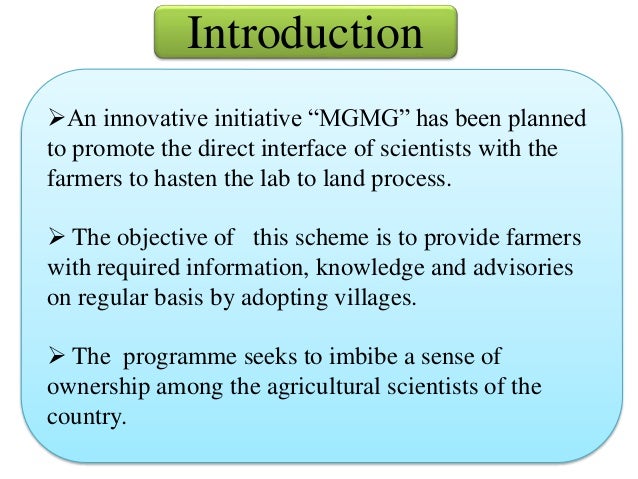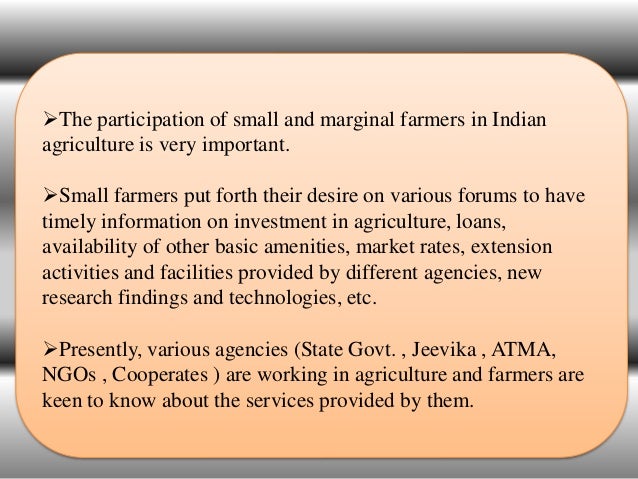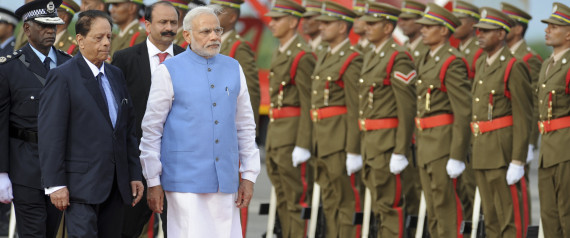Recently launched schemes by Modiji last year as far as ICAR is
concerned

Farmer FIRST:
The new proposed project – ‘Farmer
FIRST’ is an ICAR initiative to move beyond the production and productivity and
to privilege the complex, diverse & risk prone realities of majority of the
farmers through enhancing farmers-scientists contact with multi stake
holders-participation.
The focus is on Farmer’s Farm,
Innovations, Resources, Science and Technology (FIRST). Many aspects are multiple or multi; multiple stakeholders,
multiple perspectives, multiple realities, multi-functional agriculture,
multi-method approaches. There are concepts and domains that are new or new in
emphasis like food systems, trade, market chains, value chains, innovation pathways
and most of all innovation systems.
The project is conceptualized
to deal with focus on:
i) Enabling involvement of researchers for continuous interaction
with farm conditions, problem orientation, exchange of knowledge between
farmers and other stakeholders, prioritization of problems and setting up of
research agenda;
ii) Integrating components of technology for application in
different agro-ecosystems with focus on innovations and feedback;
iii) Building partnerships involving different stakeholders;
development of rural based institutions; agro-ecosystem and stakeholders
analysis and impact studies and
iv) Using the platform of the project
having commodity institutions as partners to develop commodity specific
contents for e-enabled knowledge sharing. It is envisaged that project will
provide a platform of creating linkages, capacity building, technology
adaptation and application, on-site input management, feedback and institution
building.
*********************************************************************************************************
Mera Gaon-Mera Gaurav:

- To enhance the direct interface of scientists with the farmers, an innovative initiative has been launched as “Mera Gaon- Mera Gaurav” which will hasten the lab to land approach.
- The objective of this initiative is to provide farmers with required information, knowledge and advisories on regular basis.
- Under this scheme, groups of scientists will select villages and will remain in touch with that village and provide information to farmers on technical and other related aspects in a time frame through personal visits or through telecommunication.
- In this way, 20,000
scientists of National Agricultural Research and Education System (NARES) can
work directly in villages.
 |
***********************************************
Attracting and
Retaining Youth in Agriculture (ARYA):
(Leftists will call this mnemonic as
Sanskritization :D .. nyways)
Realizing the importance of rural
youth in agricultural development especially from the point of view of food
security of the country, ICAR has initiated a programme on “Attracting and
Retaining Youth in Agriculture”.
The objectives of ARYA project are :-
(i) To attract and empower the Youth in
Rural Areas to take up various Agriculture, allied and service sector
enterprises for sustainable income and gainful employment in selected
districts,
(ii) to enable the Farm
Youth to establish network groups to take up resource and capital
intensive activities like processing, value addition and marketing, and
(iii) To demonstrate functional
linkage with different institutions and stakeholders for convergence of
opportunities available under various schemes/program for sustainable
development of youth.
ARYA project will be implemented in
25 States through KVKs, one district from each State. In one district, 200-300 rural youths will be identified
for their skill development in entrepreneurial activities and establishment of
related micro-enterprise units in the area of Apiary, Mushroom, Seed
Processing, Soil testing, Poultry, Dairy, Goatry, Carp-hatchery, Vermi-compost
etc., KVKs will involve the Agricultural Universities and ICAR
Institutes as Technology Partners. At KVKs also one or two enterprise units
will be established so that they serve as entrepreneurial training units for
farmers. The purpose is to establish economic models for youth in the villages
so that youths get attracted in agriculture and overall rural situation is
improved.
Skill development of rural youths
will help in improving their confidence levels and encourage them to pursue
farming as profession, generate additional employment opportunities to absorb
under employed and unemployed rural youth in secondary agriculture and service
related activities in rural areas. The concurrent monitoring, evaluation and
mid-term correction will be an integral part of project implementation.
*********************************************************************************************************
STUDENT READY:
- The
term READY refers to “Rural and Entrepreneurship Awareness Development
Yojana”.
- Student READY is
Skill development initiative to strengthen students with skills, so as to
enable them to tackle global
challenges, and to improve both their employability as well as ability
to set up a venture.
- Student
READY concept signifies this as a Finishing school for the undergraduate
students.
- The
students get experience of working on farm in coordination with research
stations and KVKs under RAWE Component.
- The
students also stay in villages with farm families, agro based industries,
cooperatives during phases of the RAWE programme to
enable them to get real life field experience, understating of the
problems and enable them to gain confidence to tackle these
problems.
- Approximately, 25000 graduates as Student READY will be a
mandatory requirement for the UG Degree.
- It
is an all inclusive approach to strengthen the entrepreneurship
development scenario in the country which is competent, quality conscious,
market savvy, innovative and has globally competitive entrepreneurs shall
be carefully mentored and encouraged.
- The
programme will attract youth towards agriculture and allied sector and
such ventures, when established will help improve economic conditions in
rural areas.
All out efforts are being made
to raise profitability of agriculture for making it a really attractive
occupation, especially for youth.
---------------------------------------------------------------------------------------------------------
Now let's see something other than this done by ICAR
recently !!
- Swarna
Shreya, a new rice variety for drought–prone conditions was released.
 |
- Biofortified rice variety CR Dhan 310 was commercialized successfully in the Indo-Gangetic Plains belt
- A new fish species Clarias serratobrachium sp. nov. was discovered from the wetlands along Indo-Burma border.
- To beat
drought, ICAR eyes GM sugarcane.GM sugarcane
in water-stressed areas can offer hope in Maharashtra and other parts of
India.












